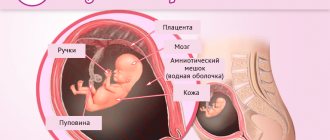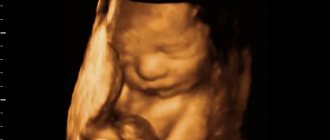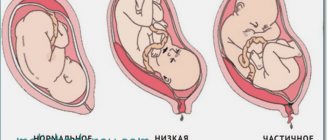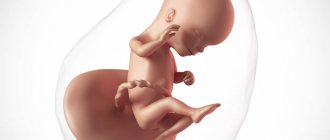Interesting Facts
| Options | Indications |
| Time from conception | 13 weeks |
| Period by month | 15 weeks |
| What month | 4 |
| Dimensions and weight of the fetus | 100-120 mm, 50-70 g |
| Uterus dimensions | Protrudes from the womb |
Your baby is the size of
Orange
100-120mm Size
50-70 g Weight
The 15th obstetric week of pregnancy, or the 13th if you count from conception, is a time of relative calm for the expectant mother, who has already gotten used to her new position. She no longer suffers from constant nausea and fatigue. In the second trimester, a lot of strength and energy appears. The baby continues to grow and develop, and very soon the woman will even be able to feel his movements.
Fetus. Development at 15 weeks
Fetus 15th week of pregnancy
The 15th obstetric week of pregnancy is a period of active growth and development of the fetus.
The future baby can already be from 10 to 14 cm long and weigh from 50 to 75 g. To visualize the size of the fetus, you can imagine an orange.
Development processes in the 15th obstetric week of pregnancy are gaining momentum.
The active formation of the brain continues. There are more and more grooves on its surface, which gradually turn into convolutions.
The cerebral cortex is activated. The number of neurons increases very quickly, and thanks to this process, the unborn child already feels a lot:
- light.
If you shine a bright lamp on the abdomen during an ultrasound, you will notice how quickly the fetus turns towards the light source;
- sound.
The basic processes of hearing development have already been completed and the hearing aid picks up sounds coming from outside.
Scientists say that the baby already remembers the voice of mom and dad (if he talks to his stomach).
After birth, the baby recognizes the people closest to him by their voices;
- taste.
The baby already has a working swallowing reflex and taste buds on the tongue.
When the mother eats sweets, the fetus begins to actively swallow amniotic fluid.
In addition to feelings, the fetus already has several important reflexes:
- thumb sucking;
- clench your hands into fists;
- shudder;
- to swallow;
- push away from the wall of the uterus if you feel it under the leg.
At the 15th week of pregnancy (according to obstetric calculations), the pituitary gland is most active in the brain: it secretes hormones that promote and control the processes of growth and development of the entire body of the fetus.
The central nervous system continues to improve and enters an active phase, establishing contacts with the peripheral nervous system, improving the functioning of existing systems.
The musculoskeletal system continues to strengthen at the 15th obstetric week of pregnancy.
The process of replacing cartilage tissue with bone tissue occurs very slowly, and therefore takes the entire period of intrauterine development and several years after birth.
A pregnant woman needs to control her diet by consuming enough foods containing calcium and magnesium.
If there are not enough microelements, the fetus will begin to take them from the reserves of the mother’s body, which will affect the condition of the teeth, nails and hair.
In order for calcium and magnesium to be absorbed in sufficient quantities, you must walk outside every day, getting vitamin D from the sun.
In winter, you can consult a gynecologist about taking this vitamin in the form of drops or a multivitamin complex.
At the 15th week of pregnancy (according to obstetric calculations), active bone growth occurs.
As a result, by the end of the week, the fetus’s legs become significantly longer than the arms, and the body proportions are as close as possible to the usual ones.
The main joints and bone connections have already been formed at the current stage, the fetus can move them unconsciously.
Due to the lack of subcutaneous fat, the fetus looks very thin. The process of transforming the skin will begin very soon, but now the skin looks red and wrinkled, although less transparent than in previous weeks.
At the 15th obstetric week of pregnancy, the fetus continues to actively move through the uterus.
Thanks to this, the muscles develop better and better, gradually forming the movements and reflexes necessary after the birth of the baby.
Lanugo (fluff) grows all over the skin and head.
Thin, colorless hairs play an important role: they prevent the leaching of the original lubricant, which is responsible for preserving the body heat of the fetus and protecting it from amniotic fluid.
This lubricant will help the baby make his way towards the world during childbirth and, if it remains in small quantities, it will quickly disappear.
An important process occurs inside large seeds. Red blood marrow (bone marrow) begins to work actively in them. Producing more and more red blood cells, it gradually takes away the hematopoietic function of the liver.
Freed from the need to perform a hematopoietic function, the liver becomes the main organ of digestion.
The respiratory system is already practically formed. The lungs have not yet developed to the final stage and are presented in the form of a glandular structure. The bronchi are expected to increase in size in the coming weeks.
The development of the reproductive system, in particular the external genitalia, continues. Boys begin to produce testerone.
Interesting! In boys and girls, the genital organs develop from an identical genital tubercle.
The Y chromosome received from the father, under the influence of hormones, allows the genital tubercle to transform into a penis.
Initially, the clitoris and penis have a common origin.
At the current stage, an ultrasound scan can already reveal the sex of the unborn child if he turns the right way. But there is still a high probability of error.
Feelings of the expectant mother
By week 15, pregnant women typically gain 2 to 5 kg in weight. If this is your first pregnancy, your belly is still barely noticeable. With each subsequent pregnancy it grows faster.
Against the background of hormonal changes and increased blood flow, bleeding gums and nasal congestion occur at week 15. Do not use vasoconstrictor drugs without a doctor's prescription, they are addictive. Rinsing with water-salt solutions and maintaining sufficient air humidity in the room will help against a runny nose during pregnancy, especially during the heating season.
To prevent diseases of the gums and teeth, visit the dentist: the 15th week of pregnancy is the optimal time for dental treatment.
Digestion
The uterus continues to grow and takes up more and more space in the abdominal cavity. Constipation may occur due to pressure on the intestines. A diet rich in fiber, sufficient fluid intake and physical activity will help you cope with them.
Breast
The mammary glands prepare for lactation throughout gestation. Already at 15 weeks, some begin to experience colostrum: a woman may notice whitish or transparent droplets of liquid coming out of the nipple.
Back pain
Physiological pain in the lower back is associated with the pressure of the growing uterus on the nerve endings. Change your body position more often, take breaks, if your job is sedentary, do gymnastics. If recommended by a doctor, you can use a bandage.
Symptoms of 14 15 weeks of pregnancy
Week 15 of pregnancy: You now have more energy and feel the same as before pregnancy, which is great, but your body is constantly changing. Pay attention to any new pregnancy symptoms so you can discuss them with your doctor. Right now, you may be experiencing dizziness, gas, heartburn, or an upset stomach, as well as the following symptoms.
Below is 15 weeks pregnant belly photo:
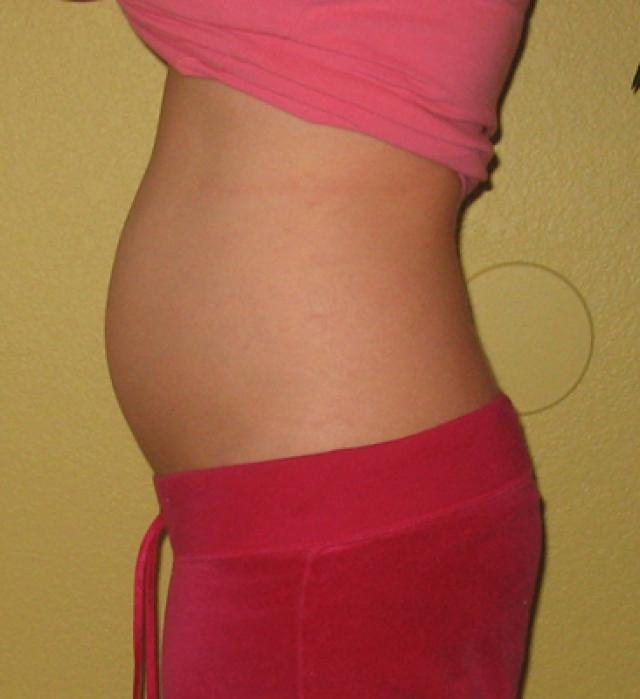
Weight gain
Typically, the recommended weight gain throughout pregnancy is only 11 to 15 kilograms. Depending on your body mass index (BMI) before pregnancy, your overall weight gain may be higher if you are underweight.
Be sure to eat healthy and not just for two! Weight gain can lead to complications during pregnancy, such as gestational diabetes and preeclampsia, which can compromise the health of you and your baby.
Changes in sexual desire
Sex during pregnancy does not cause miscarriage. However, if you have a history of early labor or miscarriage, we strongly recommend that you speak with your doctor. If you are unable to have sex or have a low libido, talk to your doctor about any health concerns you have and remember that intimacy can happen without sex.
Swollen or bleeding gums
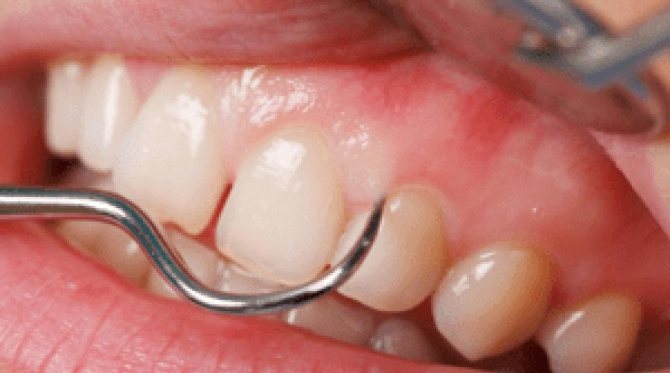
You may notice red, swollen gums or small bumps on your gums. Due to hormones (of course!) Pregnant women are more prone to gingivitis or bleeding gums when brushing or flossing. Some also report problems such as brittle teeth, tooth sensitivity, toothaches, and even tooth loss. Gingivitis can quickly develop into a bone infection, which has been linked to preeclampsia and preterm birth.
Dyspnea

Your uterus grows and remodels your organs located in your abdomen, so your lungs may not have room to expand enough to take a full breath. You may have more energy now compared to your first trimester, but your body is still working overtime to produce more blood and support your pregnancy.
Memory problems
This refers to the small bouts of forgetfulness that pregnant women have (15 to 15), and it's real since brain cell volume actually decreases during pregnancy. To combat this, write down or use an app to set reminders and make sure you get quality sleep!
Change in skin color
Your skin also changes much more than your areola. Expect some darkening of the neck area, armpits, and eventually the appearance of a dark vertical line on the abdomen, known as linea negra. Women are also known to experience irregular changes in skin color on the face, around the eyes, nose and cheeks.
Phlebeurysm

Your body is constantly producing more blood, and your veins are working extra hard to deliver blood and oxygen to your baby and other parts of your body. You may see visible veins on the chest and abdomen. However, varicose veins may appear on the legs and feet, which can also be associated with weight gain.
To prevent varicose veins from getting worse, always wear comfortable shoes to reduce stress on your feet. Stay active to improve your circulation and watch your weight. Using compression socks or support tights may also help.
Below 15 weeks of pregnancy, fetal size ultrasound photo:

What happens to the fetus
At 15 weeks of pregnancy, brain structures are actively forming. The rudiments of convolutions appear, nerve cells continue dividing and begin to coordinate the child’s actions.
The musculoskeletal system is formed, which requires calcium. Take this into account when planning your diet. A lack of calcium leads to the loss of teeth in the mother, makes her bones more fragile, and disrupts the development of the fetus. The size of the fetus at week 15 is on average 10-12 cm from crown to tailbone, weight is 50-70 grams.
Other achievements of the baby by 15 weeks
- His eyes are still closed, but he can already feel the light from outside. He hears well and responds to his mother's voice.
- Swallows amniotic fluid and can distinguish the taste of the dish you had for lunch today.
- At this stage, it is already possible to determine the blood type and Rh factor of the unborn child.
- The baby's movements are still erratic, but many women already feel his movements at 15 weeks, especially if this is not the first pregnancy.
How do the belly and uterus grow?
At week 15, the fetus can be compared in size to an orange. The pregnant uterus has already moved beyond the small sac, rising higher into the abdominal cavity. The fundus of the uterus is located at a level of 7-10 cm below the navel, or in the middle of the distance between the navel and the pubis. These parameters are measured by the midwife at each visit to the antenatal clinic, and the result is entered into the pregnant woman’s exchange card.
When performing an ultrasound at this time, it is clear that the myometrium (muscular layer of the uterus) has a uniform structure and a thickness of 2.5 cm. The uterus has increased in size so much that it can be felt in a lying position through the peritoneal wall.
The belly at this stage of pregnancy increases at different rates. For example, in thin pregnant women with developed abdominal muscles, the stomach may not be visible outwardly. And for some, a rounded tummy and smoothed waist lines are already visible to the naked eye at 15 weeks.
A vertical dark stripe in the middle of the abdomen is a manifestation of increased melanin production, which is caused by increased work of the endocrine glands. This defect will disappear soon after birth.
Tests and ultrasound
At this time, you will only have a scheduled visit to the gynecologist, where the doctor will measure your blood pressure, weight and abdominal circumference. The gynecologist palpates the uterus through the anterior abdominal wall to determine its location relative to the navel. The specialist will also listen to the fetal heartbeat.
If you are 15 weeks pregnant, you can find out the sex of the baby using an ultrasound: the baby’s genitals are fully formed and are clearly visualized. However, at this time, the study is not prescribed only for this purpose. Indications for it are various violations and suspicion of a threat of interruption. Wait just a little, during the 2nd ultrasound during pregnancy, everything secret will become clear.
Vaginal discharge at 15 weeks
Normal discharge at this stage is transparent, quite dense, sometimes with a milky white tint. Due to the predominance of estrogen, they may become somewhat thinner than they were at the beginning of pregnancy, but the color and smell of vaginal discharge from a healthy woman remains unchanged.
The appearance of a yellow or green tint, the inclusion of cheesy clots, pus or mucus, and the addition of an unpleasant odor are signs of an infectious lesion of the reproductive organs. This condition is extremely dangerous for the pregnant woman and the fetus, since some pathogenic microbes can penetrate the placental barrier. A change in the nature of the discharge is a reason to consult a doctor and begin treatment.
Possible complications
A common complaint from patients is tone at 15 weeks of pregnancy. The woman feels pain in the lower abdomen and lower back, as if everything is turning to stone. The tension persists continuously for several minutes. The tone differs from physiological spasms caused by stretching of the ligamentous apparatus by greater intensity, sometimes accompanied by slight brown vaginal discharge.
It occurs as a result of stressful situations, hormonal disorders, diabetes, hyperfunction of the thyroid gland, adhesions in the pelvis, magnesium deficiency, multiple pregnancies and many other reasons. Therefore, treatment is prescribed individually, sometimes requiring a hospital stay.
What to do if your temperature rises
If in the early stages an acute respiratory viral infection with fever could have a detrimental effect on the development of the embryo, then at week 15 the fetus already has its own immune system. A mother's temperature up to 38.5 will not harm the baby. Use an antipyretic as recommended by your doctor. Bed rest and drinking plenty of fluids will help you recover faster.
Alcohol and nicotine
Toxins entering the mother’s body after smoking a cigarette or drinking a glass almost immediately penetrate the fetus’s body through the circulatory system. At this stage of pregnancy, the cerebral cortex is actively developing, so the effects of alcohol and nicotine can negatively affect the development of the child’s intelligence and its higher mental functions.
If a pregnant woman has an irresistible urge to drink beer or wine, it may be the result of a lack of protein. The deficiency can be compensated by eating nuts or preparing a dish of lean meat.
Checklist for 15 weeks of pregnancy
- Get used to sleeping on your side: lying on your back is not recommended for pregnant women, because in this case the uterus puts pressure on important blood vessels, which can cause the baby to lack oxygen and nutrients.
- Now is the best time to go to the dentist. Do not be afraid of pain, modern painkillers are safe for the unborn child.
- Periodic dizziness and weakness at week 15 are associated with a decrease in blood sugar. Carry a snack with you, choose fruits and slow-digesting grains. Fast carbohydrates in the form of confectionery products can be included in your diet, but should not be its basis and a frequent snack.
- Walk for 20-30 minutes every day: being in the fresh air and moderate physical activity has a beneficial effect on the circulatory system of the mother and fetus.
- There is no need to deal with pigment spots that occur during pregnancy. Whitening creams may not be safe during pregnancy. Pigmentation will disappear without a trace after childbirth.
The fifteenth week of pregnancy is the best time to start attending pregnancy courses. We invite you to classes at the Women's Medical Center. You will learn a lot of interesting things about how pregnancy proceeds, how to help yourself during childbirth, how to care for a newborn. You will communicate with like-minded people and get a lot of pleasant emotions.
How you feel
By the end of the 15th week of pregnancy, all manifestations of early toxicosis (if any) should finally pass. There comes a time when you will feel a surge of strength and vigor. However, due to changes in the body, you may be concerned about the phenomenon of varicose veins. The fact is that the growing uterus puts pressure on the central veins passing behind it. This makes it difficult for blood to move from the legs to the heart. Especially often, women who have a genetic predisposition to this disease suffer from varicose veins in the 14th – 15th week of pregnancy. To prevent illness and alleviate your condition, it is recommended to follow a few simple rules:
- Avoid high-heeled shoes;
- When working sedentarily, take a ten-minute break every hour and a half, during which you can walk up the stairs or go for a walk;
- During the day, give the veins relief several times - to do this, you need to lie down for a while with your legs elevated.
If you already had varicose veins before pregnancy, consult your doctor: he may recommend that you wear compression tights or knee socks.
In addition to problems with the venous system, the expectant mother may suffer from constipation in the 14th - 15th week of pregnancy. They are a consequence of the fact that the hormone progesterone relaxes the intestinal muscles. Diet will help minimize bowel irregularities: include fresh seasonal fruits and vegetables in your diet (they are very rich in fiber) and drink more water.
At 15 weeks of pregnancy, the development of alveoli and milk ducts continues in the breast. Some of them are already capable of producing colostrum, a precursor to milk in the form of a viscous yellowish liquid. You may even notice it when you squeeze the nipple. However, there is no need to specifically stimulate the release of colostrum: due to irritation of the nipples, the hormone oxytocin is released, which causes an increase in the tone of the uterus.
Recommendations
- For this period, the recommendations of previous weeks are relevant: balance your diet (the diet should contain carbohydrates, proteins and fats), wear comfortable clothes made from natural materials, do not avoid moderate physical activity - they will allow you to stay in shape and prepare your body for childbirth;
- When going to bed, lie on your side. The 15th week of pregnancy is the time to purchase a special pillow for expectant mothers: it will relieve the strain on tired muscles of the back, neck, legs and help you completely relax;
- “Charge yourself” with positive emotions: meet with friends, spend time on your hobbies, read interesting books, listen to your favorite music and watch good films. Try not to get nervous over trifles. And be sure to talk to your baby: a baby at 15 weeks of pregnancy is already able to hear you.


